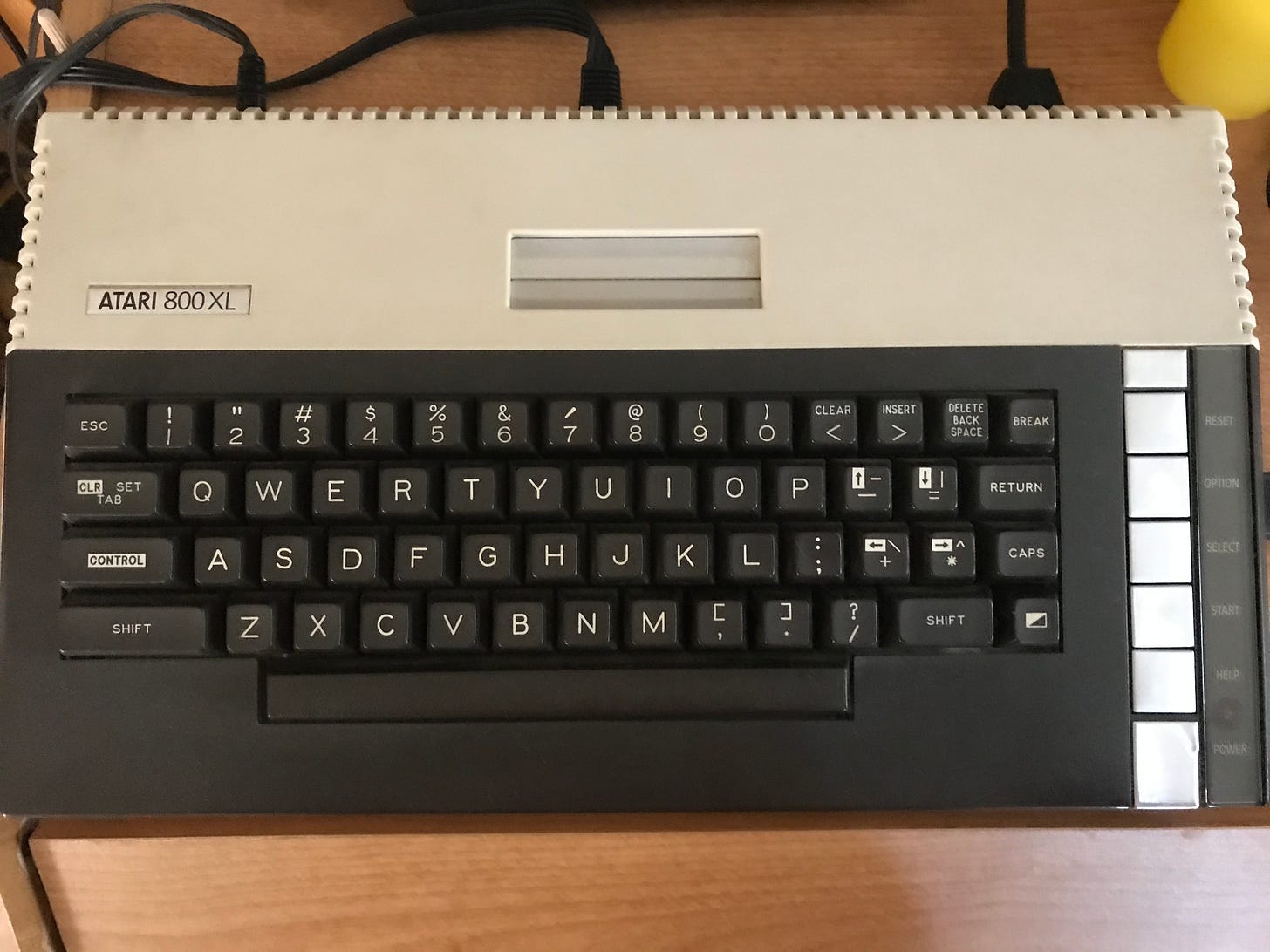Inside the Atari 800XL
Some info on its chips
Thanks for reading Goto 10! This is a free article, but if you want more great retro content, consider becoming a free or paid subscriber.
Although I own an Atari 800XL, it is not the one I had as a kid. This one is a later model because it has the Rev. C BASIC built-in, which is the latest the one without known lock-up bugs. This 800XL is not modified in any way. If you zoom in on the picture below, you’ll notice the Option key is somewhat worn out. This is pretty common because you have to hold down Option to disable the built-in BASIC, which is usually needed when running disk-based machine language games.
It really should not be necessary to do that since an ML game can disable BASIC itself, but it seems most didn’t know that was a thing at the time.
Otherwise, the computer is in good shape and the coloring is fine. It’s perhaps not quite as white as it would have been originally, but it’s not bad. The keyboard works great.
I took everything apart a while ago to clean it, so here is a quick look at its insides:
Going from left to right, you can see:
The RAM chips, 64K in total. There are 8 chips, so each chip contains 64K, but only 1 bit. To get a byte, one bit is read from each chip.
The GTIA chip (George’s Television Interface Adapter) controls communication with the TV. The 800XL can display 256 colors, 16 base colors each with 16 different luminescence levels.
ANTIC, one of the most famous Atari chips, was responsible for sending display information to the GTIA.
The 6502 CPU runs at 1.8Mhz, which is faster than the Apple II or Commodore 64. You can see all the lines running to it from the parallel bus port at the top.
The Pot(entiometer) Keyboard IC or POKEY chip handles controllers, IO and sound. That is why you hear those beeping noises when loading files from cassette or disk. This chip was also used by many arcade games of the time and even in some Atari 7800 game cartridges.
The OS ROMs are next, which are 16K.
And lastly is the BASIC ROM (8K), which is Rev. C as mentioned above.
The chip in the bottom right is the PIA (Peripheral Interface Adapter), which handles the joystick ports.
Speaking of ports, around the back are these switches and ports:
At the top left is the power switch.
Next to that is the plug for the external power supply.
The channel selector switch is next, alongside the RF modulator which connects to a TV.
Beside that is the monitor port for connecting to a composite monitor.
The open card slot is for the parallel port. This was supposed to offer great expansion capabilities for the 800XL, but it never was really used for much. Perhaps its most famous accessory is the ICD MIO device, which functioned as a sort of external RAM disk, but I’ve never seen one of them for sale.
The last port on the back is the serial input/output (SIO) port. In many ways it was an early precursor to USB.
On the side are the two joystick ports.
This is a pretty straightforward design, overall, and much simpler than the original Atari 800 internals.
Apparently my 800XL is one of the many (most?) that do not have the chroma line hooked up for monitor output, at least based on my testing. I need to do more research to see what it would take to fix that. I’m not big on soldering, but if this is easy enough perhaps I’ll give it a try. If anyone has information on this they’d like to point me towards, I’d appreciate it.
However, I mostly use my Atari 130XE these days. I like its extra RAM and better quality video output. The 800XL does have some advantages, though. If you’re looking to buy one, an 800XL is easier to find and usually cheaper. There are many different keyboards of varying quality on 800XLs, but they are all better than the one on the 130XE. Lastly, with its top-mounted cartridge port it is much easier to use cartridges with an 800XL. The cartridge port is on the back of the 130XE and it can be a bit tricky lining things up without being able to see it.
Other 8-bit Atari Articles You Might Like
Upgrading to the Atari 800XL
I really liked the Atari 400, but it did have some problems. The obvious first problem was the terrible keyboard. Sure, it was better than some of the awful membrane keyboards of the time, but it still was not good.You are reading Goto 10, the retrocomputing newsletter with a focus on Atari stuff.
Setting up my Atari 130XE
When my son came home from college last summer, the 130XE that I had set up in his room got disconnected and moved around, sitting unused for months. That needed to change!








Very nice! They are great machines. Yours here has the Stackpole keyboard, FYI. There are five different keyboards variants for the 800XL's. Lucky that yours has BASIC rev C.
Thank you for the article. I am also just getting back into Atari computing. I still have my Atari 800XL bought from Dixons with a 1050 disk drive back in the early 90's. I have bought a Meanwell 5V 15W substitute PSU for the 800XL as the original is about 30 years old.
Incidentally, the 6502C processor is Atari specific and designated Sally. It has a HALT line which a normal 6502 CPU does not so they are not interchangeble.
Atari Age has an article on the S-Video modification for the 800XL at https://atariage.com/forums/topic/41580-quick-easy-video-upgrade-for-800xl/#comments.
I have not tried this yet as I have been upgrading memory on my Atari 65XE as lots of programs require 320KB, especially if you look for them!